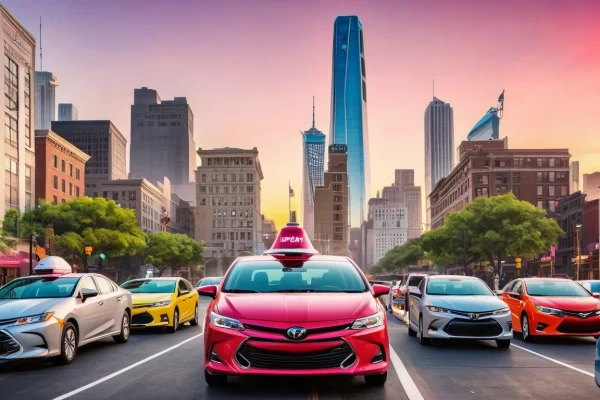Who Inspired the Rise of Lyft?

The story of Lyft is not just about a rideshare app; it’s a tale of innovation, community, and a vision that reshaped urban transportation. Understanding who inspired the rise of Lyft offers a glimpse into a world where technology meets human connection. Lyft emerged amidst a rapidly changing landscape, and its journey is marked by key figures and influential trends that propelled it to the forefront of the rideshare industry. Let’s dive into the fascinating influences that helped Lyft become a household name.
At the heart of Lyft’s story are its founders, Logan Green and John Zimmer. Their vision was crystal clear: create a transportation solution that felt more like a community than a mere service. They believed that ridesharing could foster connections between people, turning strangers into friends. This vision not only shaped Lyft’s identity but also established a unique culture that prioritized community-driven values.
Lyft’s rise was significantly influenced by the competitive landscape of the rideshare market. The strategies and innovations introduced by competitors, especially Uber, forced Lyft to adapt. This competitive pressure became a catalyst for Lyft to refine its business model and differentiate itself.
Uber’s rapid growth and market dominance were like a wake-up call for Lyft. They had to think on their feet, leading to strategic decisions that would ultimately define their place in the rideshare ecosystem. For instance, Lyft’s branding became more vibrant, focusing on a friendly image that resonated with users looking for alternatives to traditional taxis.
To stand out, Lyft embraced unique branding and customer service initiatives. Unlike Uber, Lyft emphasized a friendly and approachable demeanor. This was reflected in their pink mustaches and the tagline “Find a friend with a ride.” This approach resonated with users who craved a more personal touch in their transportation experience.
Lyft also recognized the importance of collaboration. By forming strategic partnerships with various organizations and local governments, Lyft expanded its reach and enhanced its service offerings. This strategy not only solidified its position in the competitive rideshare market but also fostered a sense of community.
The growing demand for convenient transportation options played a significant role in shaping Lyft’s service development. As urban commuters sought more flexible and reliable ways to travel, Lyft tailored its offerings to meet these evolving needs, ensuring they remained a relevant choice in the bustling rideshare landscape.
Lyft’s commitment to community engagement has been a driving force behind its rise. The company actively seeks to build strong relationships with both riders and drivers, enhancing user loyalty and brand reputation. By implementing support programs for drivers, Lyft not only improved satisfaction but also attracted a larger pool of drivers, ensuring reliable service.
Moreover, Lyft’s focus on social responsibility, including sustainability efforts and partnerships with local charities, has further distinguished the brand. This commitment attracts socially-conscious consumers who appreciate a company that cares about the community.
Finally, technological advancements have been pivotal in Lyft’s growth. By leveraging cutting-edge technology, Lyft has enhanced user experience, streamlined operations, and maintained a competitive edge in the fast-evolving rideshare landscape. The combination of innovative technology and a strong community focus makes Lyft a standout player in the industry.
In summary, the rise of Lyft is a testament to the power of vision, competition, and community. The influences that shaped this company are as diverse as its riders, and understanding these elements provides insight into what makes Lyft a leader in the rideshare space.
Founders’ Vision
The vision of Lyft’s founders, Logan Green and John Zimmer, was not just about launching a rideshare service; it was about creating a community-driven transportation solution that redefined how people connect and travel. They recognized that traditional taxi services often failed to meet the needs of modern urban commuters. Instead of merely competing in the existing landscape, they sought to cultivate a culture of friendliness and trust among riders and drivers. This vision became the backbone of Lyft’s identity, steering the company towards innovation and growth.
Green and Zimmer were inspired by their own experiences with transportation. They saw firsthand how inefficient and impersonal traditional taxi services could be. This realization led them to ask a pivotal question: How can we make transportation more personal and community-oriented? Their answer was to leverage technology to create a platform that not only connects drivers with riders but also fosters a sense of belonging.
| Key Elements of Lyft’s Vision | Description |
|---|---|
| Community Focus | Building relationships between drivers and riders to create a supportive environment. |
| Innovative Technology | Utilizing mobile apps to streamline the rideshare experience and enhance user convenience. |
| Inclusive Culture | Encouraging diversity and inclusivity within the driver and rider community. |
To further emphasize their commitment to community, Lyft implemented several initiatives aimed at enhancing user experience. These included:
- Driver Empowerment: Providing drivers with tools and resources to succeed.
- Rider Engagement: Creating programs that reward loyal riders.
- Feedback Mechanisms: Actively seeking input from both drivers and riders to improve services.
Ultimately, the vision set forth by Logan Green and John Zimmer was a game-changer. It wasn’t just about getting from point A to point B; it was about fostering a community that values connection and trust. Their innovative approach has not only shaped Lyft’s trajectory but has also inspired countless other startups in the transportation sector.
Influence of Competitors
The competitive landscape of the rideshare industry has been nothing short of a thrilling race, with each player pushing the boundaries of innovation and service. Lyft, in its quest to establish itself as a major player, has been significantly influenced by its competitors, particularly Uber. This rivalry has not only shaped Lyft’s business strategies but also its overall identity. The need to differentiate itself from Uber’s aggressive market tactics led Lyft to adopt a more community-focused approach, which has become a hallmark of its brand.
Lyft recognized early on that to thrive, it needed to respond to the challenges posed by its competitors. Here are some key influences that shaped Lyft’s evolution:
| Influence | Description |
|---|---|
| Market Dominance of Uber | The rapid expansion and aggressive pricing strategies of Uber forced Lyft to rethink its own business model. |
| Innovative Features | Competitors introduced features like ride-sharing and in-app payments, prompting Lyft to innovate its offerings. |
| Customer Expectations | As consumers became accustomed to high standards of service, Lyft had to elevate its customer experience. |
Moreover, Lyft’s branding strategy was heavily influenced by the need to stand out in a crowded market. While Uber focused on a more corporate image, Lyft embraced a friendly and approachable persona. This is reflected in their marketing campaigns, which often highlight community and social interaction. For instance, Lyft’s slogan, “Find a ride, make a friend,” encapsulates this philosophy beautifully.
In response to the competitive pressures, Lyft also launched several initiatives aimed at enhancing user experience, such as:
- Unique Branding: Lyft’s pink mustache became a symbol of its brand, representing its quirky and friendly approach.
- Customer Service Innovations: Enhanced support channels and user-friendly app features have set Lyft apart.
- Community Engagement: Collaborations with local businesses and charities have reinforced its community-driven ethos.
Ultimately, the influence of competitors like Uber has been a double-edged sword for Lyft. While it has posed challenges, it has also spurred innovation and growth, allowing Lyft to carve out its own niche in the bustling rideshare market. The company’s ability to adapt and thrive amidst fierce competition is a testament to its resilience and vision.
Uber’s Impact
When we think about the rise of Lyft, we can’t ignore the significant influence that Uber has had on its journey. Uber’s rapid growth and market dominance created a competitive landscape that forced Lyft to rethink its strategies and refine its business model. It’s like being in a race where your opponent is not just fast, but also constantly changing the rules. So, how did Lyft respond to this challenge?
First off, Lyft had to identify what made Uber so appealing to consumers. The convenience of hailing a ride with just a tap on a smartphone screen was revolutionary. To compete, Lyft focused on enhancing its own user experience by:
- Improving app functionality
- Streamlining the ride request process
- Implementing a more reliable driver rating system
Moreover, Lyft recognized that to stand out, it needed to create a unique identity. This led to the development of a friendly and community-focused brand image, which was a stark contrast to Uber’s more corporate feel. Lyft’s branding efforts included:
- Bright pink mustaches on cars, symbolizing a fun and approachable service
- Marketing campaigns emphasizing community and social interaction
- Engaging with riders through social media to foster loyalty
In an industry where consumer trust is paramount, Lyft’s emphasis on safety and community engagement played a crucial role in attracting users who might have been wary of Uber’s controversies. For instance, Lyft’s Driver and Rider Safety Program was launched to ensure that both parties felt secure during their rides. This initiative not only improved user satisfaction but also helped build a positive reputation.
As the rideshare wars unfolded, Lyft’s ability to adapt and innovate in response to Uber’s strategies was crucial. The competition pushed Lyft to not only keep pace but also to carve out its niche, ultimately leading to a more diversified and resilient business model. Lyft’s journey is a testament to how competition can drive innovation and shape the future of an industry.
| Aspect | Uber | Lyft |
|---|---|---|
| Brand Image | Corporate and Professional | Friendly and Community-Focused |
| Safety Initiatives | Standard Safety Features | Enhanced Safety Programs |
| Market Strategy | Aggressive Expansion | Community Engagement |
In conclusion, Uber’s impact on Lyft was profound, acting as both a catalyst for growth and a benchmark for improvement. By learning from its competitor’s strengths and weaknesses, Lyft not only survived but thrived, establishing itself as a key player in the rideshare industry.
Market Differentiation
In the fiercely competitive rideshare market, Lyft recognized early on that to thrive, it needed to carve out a distinct identity that set it apart from giants like Uber. This journey of was not just about offering rides; it was about creating an experience that resonated with users on a personal level. Lyft’s founders, Logan Green and John Zimmer, believed in the power of community and connection. They understood that consumers were looking for more than just a ride—they wanted a friendly face and a sense of belonging.
To achieve this, Lyft implemented several unique branding strategies that emphasized its commitment to community and customer service. Unlike its competitors, Lyft adopted a pink mustache branding for its cars, which quickly became a symbol of friendliness and approachability. This visual cue was more than just a marketing gimmick; it represented a promise of a pleasant ride experience. Lyft’s slogan, “Find a new friend every time you ride,” encapsulated its mission to foster connections between drivers and passengers.
| Lyft’s Unique Features | Comparison with Uber |
|---|---|
| Friendly branding (pink mustache) | Standard branding |
| Community-focused initiatives | Profit-driven strategies |
| Driver and rider engagement programs | Minimal engagement |
Furthermore, Lyft’s approach to customer service was a game-changer. They introduced features like in-app tipping and the ability to choose your driver, which not only enhanced user satisfaction but also encouraged a more personal connection. This level of engagement fostered a sense of loyalty among riders, making them more likely to choose Lyft over other options. As a result, Lyft’s brand became synonymous with a welcoming atmosphere, drawing in users who were tired of the impersonal nature of traditional taxi services.
In conclusion, Lyft’s market differentiation strategy was not merely about competing with Uber; it was about creating a unique space in the rideshare industry. By focusing on community, branding, and exceptional customer service, Lyft transformed the way people perceive ridesharing. As the company continues to evolve, its commitment to these core principles remains a beacon of inspiration in the ever-changing landscape of transportation.
Strategic Partnerships
When we think about the meteoric rise of Lyft, it’s hard not to acknowledge the that played a pivotal role in its success. These collaborations have not only broadened Lyft’s reach but have also enriched its service offerings, allowing it to adapt swiftly to the ever-changing rideshare landscape. Imagine a puzzle; each partnership is a piece that fits perfectly, creating a bigger picture of community and innovation.
One of the most significant aspects of Lyft’s partnerships is its collaboration with local governments and transit authorities. By aligning with these entities, Lyft has been able to integrate its services into existing public transportation systems, providing a seamless travel experience for users. For example, in cities like San Francisco and Los Angeles, Lyft has partnered with public transit to offer discounted rides that encourage the use of shared transportation. This not only helps reduce traffic congestion but also promotes a sustainable approach to urban mobility.
| Partnership Type | Key Benefits |
|---|---|
| Local Government | Enhanced service integration and reduced traffic congestion |
| Corporate Collaborations | Expanded user base and promotional discounts |
| Charity Organizations | Increased brand loyalty and community engagement |
Moreover, Lyft has formed partnerships with various corporations, allowing businesses to offer rides as employee benefits. This not only boosts Lyft’s visibility but also creates a loyal customer base that appreciates the convenience of rideshare services. Imagine getting a ride to work, all thanks to your employer’s initiative—it’s a win-win!
In addition to corporate partnerships, Lyft has also made strides in social responsibility by collaborating with local charities. These initiatives not only enhance Lyft’s brand image but also foster a sense of community, appealing to socially-conscious consumers. By participating in local events and supporting charitable causes, Lyft demonstrates its commitment to making a positive impact.
In conclusion, Lyft’s strategic partnerships have been instrumental in shaping its identity and expanding its influence in the rideshare market. By working together with various organizations, Lyft has created a robust ecosystem that not only benefits its users but also promotes a sustainable and community-oriented approach to transportation.
Consumer Demand
When it comes to the rise of Lyft, understanding is like peering into a crystal ball that reveals the future of transportation. As urban areas become increasingly congested, the need for convenient, reliable, and affordable transportation options has skyrocketed. People are no longer satisfied with traditional taxi services; they crave something more tailored to their fast-paced lifestyles. This shift in consumer behavior has been a game-changer for Lyft, pushing the company to innovate and adapt in ways that resonate deeply with users.
Lyft recognized early on that to thrive, it needed to listen to the voices of its riders. By conducting extensive market research and gathering feedback, Lyft was able to pinpoint specific desires and pain points among urban commuters. For instance, many riders expressed a longing for a more personal touch in their rideshare experiences. They wanted drivers who were not just service providers, but also friendly faces that made their journeys enjoyable. This insight led Lyft to implement features that prioritize user experience, such as:
- In-app ratings for drivers and passengers
- Community guidelines encouraging positive interactions
- Enhanced safety measures to ensure peace of mind
Moreover, the growing trend of on-demand services played a pivotal role in shaping Lyft’s offerings. The modern consumer values flexibility and accessibility, and Lyft capitalized on this by providing a user-friendly app that allows riders to request a ride with just a few taps. This seamless experience not only meets consumer expectations but also creates a sense of loyalty among users.
In a world where convenience reigns supreme, Lyft has positioned itself as a leader in meeting the demands of urban dwellers. The company’s ability to adapt quickly to changing consumer needs is reflected in its continuous evolution of services, including:
| Service | Description |
|---|---|
| Lyft XL | For larger groups needing extra space. |
| Lyft Line | Affordable ridesharing with other passengers heading in the same direction. |
| Lyft Lux | Premium rides with high-end vehicles for a touch of luxury. |
In conclusion, the surge in consumer demand has not only inspired Lyft’s growth but has also cemented its place in the rideshare industry. As the company continues to evolve, it remains committed to understanding and responding to the needs of its riders, ensuring that they always have a reliable option at their fingertips.
Community Engagement
When we talk about Lyft, one of the key pillars that supports its rapid rise in the rideshare industry is its unwavering commitment to . This isn’t just a buzzword for them; it’s a core part of their DNA. Lyft has consistently sought to build strong relationships with both riders and drivers, creating a community that feels more like a family than a mere transaction. Imagine hopping into a car where the driver knows your name, your favorite music, and even your preferred route—this is the kind of personal touch Lyft aims to provide.
Lyft’s approach to community engagement is multifaceted. They have implemented various programs designed to enhance the experience for both drivers and riders. For instance, the company has rolled out initiatives aimed at fostering a sense of belonging, which not only boosts user loyalty but also elevates the overall brand reputation. Below is a table showcasing some of Lyft’s key community engagement initiatives:
| Initiative | Description | Impact |
|---|---|---|
| Driver Support Programs | Programs designed to assist drivers with resources and community support. | Increased driver satisfaction and retention. |
| Local Partnerships | Collaborations with local charities and organizations. | Strengthened community ties and enhanced brand image. |
| Sustainability Efforts | Initiatives aimed at reducing Lyft’s environmental impact. | Attracted environmentally conscious consumers, boosting brand loyalty. |
Moreover, Lyft has also embraced social responsibility as a vital component of its community engagement strategy. This includes partnerships with local charities, which not only help those in need but also resonate with socially-conscious consumers who want to support brands that care. For example, Lyft often collaborates with organizations focused on environmental sustainability, aligning their brand with values that matter to their customers.
In essence, Lyft’s community engagement efforts are not just about providing a service; they are about creating a movement—a movement that emphasizes connection, support, and responsibility. As they continue to innovate and adapt, one thing remains clear: Lyft is not just changing the way we think about transportation; they are redefining what it means to be part of a community.
Driver Support Programs
Lyft’s commitment to its drivers is not just a business strategy; it’s a core value that sets the company apart in the rideshare industry. By implementing various , Lyft aims to create a positive environment that not only enhances driver satisfaction but also ensures reliable service for riders. Imagine being part of a community where your efforts are recognized and rewarded—this is the essence of Lyft’s approach.
One of the standout features of Lyft’s support system is its comprehensive training program. New drivers are provided with resources that guide them through the onboarding process, ensuring they feel confident and prepared. The training includes:
- Safety protocols and best practices
- Navigation tips and tricks
- Customer service excellence
Moreover, Lyft offers financial incentives and bonuses through various initiatives, which can significantly boost a driver’s earnings. For instance, the Weekly Earnings Guarantee ensures that drivers can earn a minimum amount over a specified period, providing them with a sense of financial security. This program, along with others, reflects Lyft’s understanding of the challenges faced by drivers in a competitive market.
In addition to financial support, Lyft also emphasizes community building. By organizing local events and meet-ups, drivers can connect with one another, sharing experiences and tips. This fosters a sense of belonging and camaraderie that is often missing in gig economy jobs. As one driver put it, “It’s not just about the ride; it’s about the relationships we build along the way.”
To further illustrate the impact of these programs, let’s take a look at the following table that summarizes key aspects of Lyft’s Driver Support Programs:
| Program | Description | Benefits |
|---|---|---|
| Training Program | Comprehensive onboarding for new drivers | Increased confidence and safety awareness |
| Financial Incentives | Bonuses and earnings guarantees | Enhanced earning potential and financial stability |
| Community Events | Local meet-ups for drivers | Stronger relationships and support networks |
In conclusion, Lyft’s Driver Support Programs not only enhance the overall driving experience but also play a crucial role in attracting and retaining drivers. By prioritizing driver satisfaction and community engagement, Lyft continues to inspire loyalty and growth in the ever-competitive rideshare market.
Social Responsibility Initiatives
Lyft has always been more than just a rideshare service; it has positioned itself as a socially responsible company committed to making a positive impact in the communities it serves. This ethos is not just a marketing strategy; it’s deeply embedded in the company’s culture and operations. Lyft’s social responsibility initiatives reflect a desire to give back and contribute to a more sustainable and equitable world.
One of the standout initiatives is Lyft’s commitment to sustainability. The company has set ambitious goals to reduce its carbon footprint by promoting electric vehicle (EV) usage among its drivers. In fact, Lyft has pledged to become a 100% carbon-neutral platform by 2025. This commitment not only helps the environment but also encourages drivers to make eco-friendly choices.
Additionally, Lyft actively partners with local charities and organizations to support various community-driven projects. For instance, through its Lyft for Good program, the company provides free or discounted rides to individuals in need, such as those attending medical appointments or participating in community service events. This initiative exemplifies how Lyft seeks to enhance social welfare and strengthen community ties.
To illustrate the impact of Lyft’s social responsibility initiatives, consider the following table that highlights some of their key programs:
| Initiative | Description | Impact |
|---|---|---|
| Carbon Neutrality | Commitment to 100% carbon-neutral rides by 2025. | Reduction in greenhouse gas emissions. |
| Lyft for Good | Free or discounted rides for community service and medical appointments. | Improved access to essential services for underserved populations. |
| Partnerships with Charities | Collaboration with local organizations to support community projects. | Enhanced community engagement and support. |
These initiatives not only enhance Lyft’s brand reputation but also resonate with today’s socially conscious consumers, who increasingly prefer to support companies that prioritize ethical practices. By focusing on social responsibility, Lyft is not just aiming for growth; it’s striving to create a lasting positive impact in the world. As the company continues to innovate and expand, its commitment to social responsibility will undoubtedly remain a cornerstone of its identity.
Technological Innovations
The journey of Lyft is not just about rides; it’s about transforming the way we think about transportation. have been at the heart of this transformation, propelling Lyft into a league of its own in the rideshare industry. From the moment you tap that app on your smartphone to the moment you step out of the car, technology is seamlessly woven into the fabric of your experience. But what exactly are these innovations that have fueled Lyft’s rise?
One of the standout features that Lyft has introduced is its user-friendly app interface. The simplicity and efficiency of the app make it easy for riders to request a ride, track their driver, and even share their trip details with friends or family for safety. This focus on user experience has not only attracted riders but also created a loyal customer base that keeps coming back. It’s like having a personal concierge in your pocket!
Moreover, Lyft has embraced data analytics to optimize its operations. By analyzing ride patterns, user preferences, and peak demand times, Lyft can deploy its drivers more effectively, ensuring that riders experience minimal wait times. This data-driven approach is crucial in a competitive market where every second counts. To illustrate, here’s a table showcasing some key technological innovations that have driven Lyft’s success:
| Innovation | Description | Impact |
|---|---|---|
| User-Friendly App | Intuitive design for easy ride requests | Increased user satisfaction and retention |
| Data Analytics | Optimizing driver deployment through data | Reduced wait times, improved efficiency |
| Safety Features | Real-time tracking and ride-sharing options | Enhanced rider safety and trust |
Additionally, Lyft has invested in safety features that prioritize the well-being of both riders and drivers. Features such as in-app emergency assistance and ride-sharing options ensure that users feel secure during their travels. It’s a testament to how technology can foster trust in a service that relies heavily on community interaction.
In conclusion, Lyft’s commitment to has not only set it apart from competitors but has also redefined the rideshare experience. As technology continues to evolve, Lyft remains poised to adapt and innovate, ensuring that it meets the ever-changing needs of urban commuters. So, the next time you hop into a Lyft, remember that there’s a world of technology working behind the scenes to make your ride as smooth as possible!
Frequently Asked Questions
- What inspired the founders of Lyft to start the company?
The founders, Logan Green and John Zimmer, were inspired by the need for a community-driven transportation solution. They envisioned a platform that not only provided rides but also fostered connections among riders and drivers, creating a unique culture that emphasized friendliness and support.
- How did Lyft differentiate itself from competitors like Uber?
Lyft set itself apart by focusing on a community-oriented approach and enhancing customer service. They developed a brand that resonated with users looking for a more personal and friendly alternative to traditional ridesharing, which helped them build a loyal customer base.
- What role did technology play in Lyft’s growth?
Technological innovations have been crucial for Lyft, enabling them to streamline operations and enhance user experience. By leveraging advanced algorithms and user-friendly apps, Lyft has been able to maintain a competitive edge and adapt to the fast-evolving rideshare market.
- How does Lyft support its drivers?
Lyft has implemented various support programs aimed at improving driver satisfaction. These initiatives not only help attract a larger pool of drivers but also create a positive community atmosphere, ensuring reliable service for riders.
- What social responsibility initiatives does Lyft engage in?
Lyft is committed to social responsibility through sustainability efforts and partnerships with local charities. This focus on giving back has attracted socially-conscious consumers who value brands that prioritize community and environmental impact.





